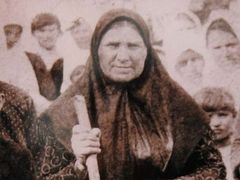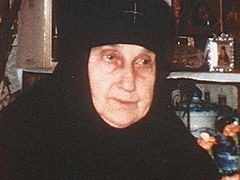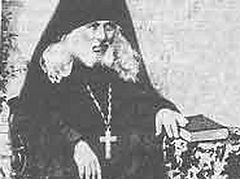 The calling to the monastic path is special. A man who has accepted it as the will of God for himself overcomes all obstacles and temptations encountered on the path through great love for Christ and one day fulfills the desire of his heart. If the basis of life is initially the fulfillment of the commandments of God, then with this desire, monasticism begins long before a person comes to the monastery, and under circumstances far from the monastic life.
The calling to the monastic path is special. A man who has accepted it as the will of God for himself overcomes all obstacles and temptations encountered on the path through great love for Christ and one day fulfills the desire of his heart. If the basis of life is initially the fulfillment of the commandments of God, then with this desire, monasticism begins long before a person comes to the monastery, and under circumstances far from the monastic life.
Evdokia Yakovlevna Sukhanova was born on March 1 (old style), 1820 in a peasant family. From her earliest years, she loved solitary prayer and the church services. In her youth, she was already contemplating the meaning of life, and the desire to dedicate herself to God grew in her soul.
Her parents were deeply religious people, but they envisioned their daughter’s life differently, and her father compelled her to marry. She had a son in her marriage. According to tradition, Evdokia’s husband died in the Russo-Turkish War, and later, by some absurd incident, she lost her only son, by then grown and married (his widow later became the cell attendant of St. Zosima and never left her until her death).
Seeing the will of God in this, soon after the death of her family, the ascetic entered the Holy Protection-Ennatsky Monastery, located on the territory of the Sterlitamak Canton in the Ufa Diocese. Years later, the Lord led her to become the last abbess of the monastery.
Precise information about when Evdokia was tonsured in the mantia with the name Evniky (Eunice) has not been preserved. Her spiritual life was concealed from external gazes. The Life of the saint includes stories about several of her trips on foot to Jerusalem and about a spring dug not far from the monastery during her ascetic labors. Later, a skete was built near this spring with a chapel in honor of the Most Holy Trinity and an apiary.
It was probably 1919 when Mother Evniky received the Great Schema with the name Zosima. She was tonsured by Bishop Andrei of Ufa and Menzelin (Ukhtomsky; Vladyka was appointed to the Ufa Cathedra on December 22, 1913 and remained there until his arrest in early 1920). From her tonsuring in the schema until her blessed repose, St. Zosima slept in a cypress coffin she brought from her last pilgrimage to the Holy Land in 1912. According to the recollections of her contemporaries, it was in this coffin that they carried her out of the monastery when they closed it in 1923.
After the closing of the monastery, Mother Zosima first settled in the village of Novo-Arkhangelovka, in a small house built in the yard of one pious family. However, due to the persecution from the authorities, she was later forced to repeatedly move from place to place.
 Many people would come to the eldress for spiritual advice, and she did not leave a single one of them without help and prayer. Testifying to her faith in Christ with her life, by her podvigs, prayers, and confession, the saint added to, preserved, and strengthened the faith in the souls of those who spoke with her, to whom she verbally transmitted her spiritual experience and the traditions of the monastic life. The venerated elder of our day Schema-Archimandrite Seraphim (Tomin; 1923-2013), the founder and spiritual father of St. Andrew’s Monastery in the village of Andreevka in the Saraktash District of the Orenburg Province, a resident of the Russian St. Panteleimon’s Monastery on Mt. Athos in the 1970s, left his spiritual children an amazing story about how Mother Zosima healed him in infancy, and then foretold both his monasticism and his time on the Holy Mountain… To each of those who came to her for help and guidance, Matushka revealed the fruit of God’s love, which, according to St. Tikhon of Zadonsk, is “love of neighbor. For if we love someone, then we also love him whom our beloved loves. God undoubtedly loves man: Thus, he who loves God also loves his neighbor. In the words of the holy apostle John the Theologian, love is known in love of neighbor and God: If a man say, I love God, and hateth his brother, he is a liar (1 Jn. 4:20).
Many people would come to the eldress for spiritual advice, and she did not leave a single one of them without help and prayer. Testifying to her faith in Christ with her life, by her podvigs, prayers, and confession, the saint added to, preserved, and strengthened the faith in the souls of those who spoke with her, to whom she verbally transmitted her spiritual experience and the traditions of the monastic life. The venerated elder of our day Schema-Archimandrite Seraphim (Tomin; 1923-2013), the founder and spiritual father of St. Andrew’s Monastery in the village of Andreevka in the Saraktash District of the Orenburg Province, a resident of the Russian St. Panteleimon’s Monastery on Mt. Athos in the 1970s, left his spiritual children an amazing story about how Mother Zosima healed him in infancy, and then foretold both his monasticism and his time on the Holy Mountain… To each of those who came to her for help and guidance, Matushka revealed the fruit of God’s love, which, according to St. Tikhon of Zadonsk, is “love of neighbor. For if we love someone, then we also love him whom our beloved loves. God undoubtedly loves man: Thus, he who loves God also loves his neighbor. In the words of the holy apostle John the Theologian, love is known in love of neighbor and God: If a man say, I love God, and hateth his brother, he is a liar (1 Jn. 4:20).
Schemanun Zosima reposed on the night of March 1, 1935, on her 115th birthday, in the village of Sentsovka in the Sharlik District of the Orenburg Province. She was buried in the village cemetery. Because of a report that there was gold and jewelry buried with her, her grave was opened after her burial by order of the authorities. Of course, nothing was found in it.
The relics of the venerable eldress were uncovered on December 14, 2003, and transferred to the Kazan Theotokos Church in the city of Meleuza in the Ufa Diocese, then to the St. John the Forerunner Church in the city of Kumertau.
Many faithful labored for the glorification of St. Zosima. A great contribution to this blessed work was made by Fr. Seraphim (Tomin), and materials for her canonization and the writing of her Life were carefully gathered. On June 11, 2006, on the feast of Pentecost, in the Martha and Mary Convent in the village of Ira in the Kumertau District of the Ufa Diocese, Archbishop Nikon of Ufa and Sterlitamak celebrated the rite of glorification of St. Zosima of Ennatsky among the locally-venerated saints.
The saint’s holy relics are now located in the Holy Protection-Ennatsky men’s Monastery in the Salavat Diocese,[1] where her monastic path began.






